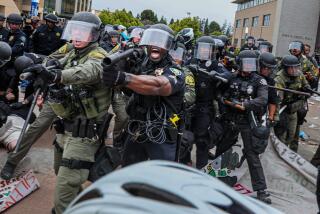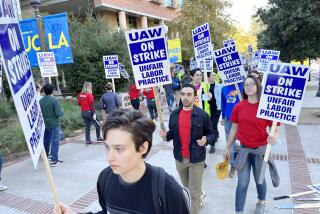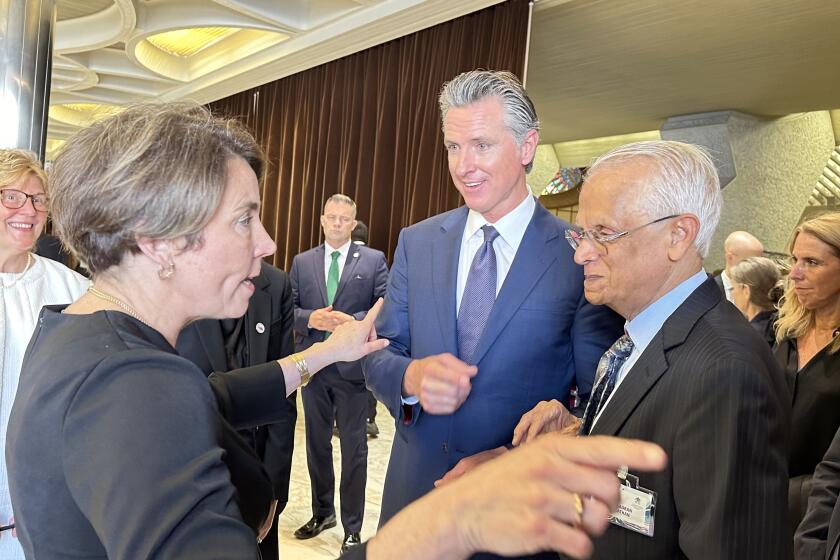Civic Center Security Called Too Restrictive
As the Los Angeles Civic Center continues to operate under intense security, local leaders are expressing concern that efforts to guard against a terrorist attack may be robbing residents of their access to public buildings and meetings.
In one move that might conflict with state laws guaranteeing open meetings, officials have turned away more than a dozen people from City Hall because they did not have photo identification. Those who are allowed in must go through a metal detector and stop at a guard station, where they sign their names in a log.
“While protecting safety is essential, it cannot be done in a way that bars people from attending public meetings or using a public building,” said USC law professor Erwin Chemerinsky.
“These buildings are owned by the people. And government meetings are the meetings of the people. What if someone doesn’t want to show an ID? They still have a right to attend the meeting.”
Government officials have been struggling to find a balance between safety and open government in the downtown Civic Center area--home to a number of city, county, state and federal government buildings.
Since the U.S. started its bombing campaign in Afghanistan, Civic Center officials have imposed various security measures, including hiring armed guards and sealing off the perimeter of their buildings.
Across the street from City Hall, federal marshals with automatic weapons keep vigil at the U.S. District Courthouse. A black armored vehicle is parked near the Main Street entrance, where members of the public are searched before they enter the building. Up the street at the county Hall of Administration, visitors are prohibited from parking along the curb and in the underground lot.
“I think beefing up security is something that has to be done in light of the current environment,” said County Supervisor Zev Yaroslavsky. “But there’s a fine line. On one hand, these buildings are natural targets for some nut or some organization of nuts. On the other hand, these buildings represent the fundamentals of our democracy. Somewhere in between there’s a happy medium.”
For days, members of the Los Angeles City Council have been grappling with security issues. Some civil libertarians worry that the new procedures violate California law by requiring identification of people attending public meetings.
In addition to requiring photo IDs of all visitors, officials have also opted to close off the streets between City Hall and Parker Center--causing major traffic congestion in the area. So far, there are no plans to reopen the streets.
“If we decide to make those barricades permanent,” said Council President Alex Padilla, “there has got to be a more effective, more efficient arrangement for members of the public and employees to access the Civic Center, better than what is happening now.”
Councilman Nick Pacheco, however, complained that having the barricades “sends the wrong message.”
“We need to balance the need for security while at the same time not feeling like we are in some kind of encampment situation,” he said.
But other council members said the city should err on the side of caution.
“The heart of the city is here in the Civic Center,” Councilman Ed Reyes said. “If we’re not here, who is going to run the store?”
Councilman Mark Ridley-Thomas on Friday urged his colleagues to approve the expenditure of $3.5 million on additional security measures, including setting up an extensive electronic surveillance system around the building. A deeply divided council, however, rejected that proposal. The matter will be up for debate again next week.
“We can simply not afford not to do it. We must do this,” Ridley-Thomas said. “Why? Because if we want to send a clear message that we are serious about security in a constituent-friendly manner, we must act preventively and protectively.”
Meanwhile, Police Chief Bernard C. Parks said he supports leaving the barricades up until potential threats and effects can be studied further.
“My recommendation is that they stay for a period of time so we can assess the flow of what is going on and we can assess the intelligence information,” Parks said. “I think we are safe, but again, I think we have to take whatever precautions that are necessary and we have to look at short- and long-term issues to continue the safety.”
Since last week, those entering City Hall have had to pass through a metal detector and have their bags searched by guards--a procedure that some people say takes too long.
People entering the Federal Building on Los Angeles Street and the state’s Reagan Building on Spring Street are also now required to show identification.
Complicating matters, many of the underground parking structures in the area have been closed to the public--forcing Civic Center visitors to park blocks away.
Government employees are allowed to park in underground lots only after they show their parking permit and photo identification--sometimes at several points. Some city employees complain that they have been subjected to six or more security checks just to get to their offices.
The heightened security measures have had another unintended impact at City Hall: There has been a noticeable drop in the number of people addressing the council during meetings’ public comment periods. And it’s been weeks since any of the council gadflies--usually fixtures--have showed up to air their concerns.
“Historically, we have always had free and open access to public buildings--perhaps too free and open,” said Steven Erie, a professor who studies Los Angeles politics. “In the past we have erred too much in terms of access. Now it seems we are overreacting. There’s a balance. We’re just not there yet.”
*
Times staff writers Jean Guccione and Patrick McGreevy contributed to this report.
More to Read
Start your day right
Sign up for Essential California for news, features and recommendations from the L.A. Times and beyond in your inbox six days a week.
You may occasionally receive promotional content from the Los Angeles Times.






